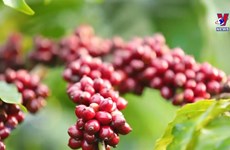Coffee sector gears up for sustainable growth
Coffee growers in the Central Highlands are replacing their old trees
with new plants in efforts to increase the yield and quality of coffee
beans.
Coffee growers in the Central Highlands are replacing their old trees
with new plants in efforts to increase the yield and quality of coffee
beans.
As one of the world’s top coffee exporters, Vietnam now has more than 525,000 hectares under coffee trees, 90 percent of which are in the Central Highlands. However, statistics by the Vietnam Coffee-Cacao Association showed that in the next 3-5 years, half of the coffee trees in the country will reach 20 years old, which mean they are too old to bear profitable yields. In that context, the Tay Nguyen Agriculture and Forestry Science Institute has been providing farmers with young plants and seeds of new strains.
According to the institute’s director Le Ngoc Bau, scientists from the institute have produced several varieties of Robusta coffee, which have received permission from the Ministry of Agriculture and Rural Development to be grown on large scale. The new varieties produce high yield with bigger beans and are highly resistant to diseases.
Besides supplying between 500,000 to 1 million young plants and 20 tonnes of seeds, as well as more than 200,000 grafts each year to replace old trees, the institute has also provided coffee farmers with advanced cultivation techniques and taught them how to intercrop to increase income.
Bau proposed that the Government, ministries and sectors should increase investment in scientific and technological research on the cultivation of coffee tree, taking into account the plant’s important role in the national economy.
He said it is necessary to conduct a comprehensive research programme on the coffee industry’s entire production process to help increase the added value of this export staple and help the sector achieve sustainable growth.
In the 2011-2012 crop, the country earned nearly 3.4 billion USD from exporting around 1.6 million tonnes of coffee bean.-VNA
As one of the world’s top coffee exporters, Vietnam now has more than 525,000 hectares under coffee trees, 90 percent of which are in the Central Highlands. However, statistics by the Vietnam Coffee-Cacao Association showed that in the next 3-5 years, half of the coffee trees in the country will reach 20 years old, which mean they are too old to bear profitable yields. In that context, the Tay Nguyen Agriculture and Forestry Science Institute has been providing farmers with young plants and seeds of new strains.
According to the institute’s director Le Ngoc Bau, scientists from the institute have produced several varieties of Robusta coffee, which have received permission from the Ministry of Agriculture and Rural Development to be grown on large scale. The new varieties produce high yield with bigger beans and are highly resistant to diseases.
Besides supplying between 500,000 to 1 million young plants and 20 tonnes of seeds, as well as more than 200,000 grafts each year to replace old trees, the institute has also provided coffee farmers with advanced cultivation techniques and taught them how to intercrop to increase income.
Bau proposed that the Government, ministries and sectors should increase investment in scientific and technological research on the cultivation of coffee tree, taking into account the plant’s important role in the national economy.
He said it is necessary to conduct a comprehensive research programme on the coffee industry’s entire production process to help increase the added value of this export staple and help the sector achieve sustainable growth.
In the 2011-2012 crop, the country earned nearly 3.4 billion USD from exporting around 1.6 million tonnes of coffee bean.-VNA













